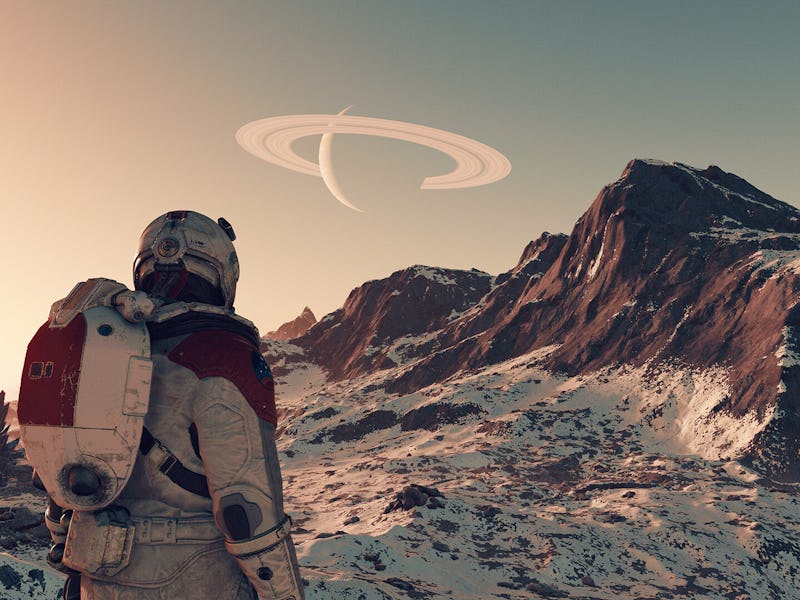Ex-Bethesda Employee Reveals the Biggest Problem With Starfield
Bigger isn’t better.

The first time we saw Starfield in action, during a 2022 Xbox Games Showcase, one figure stood out from everything else. Director Todd Howard revealed Starfield would take place on “over 1,000 planets, all open for you to explore.”
From a technical standpoint, that’s an impressive feat for developer Bethesda, but to many — myself included — it just sounds exhausting. Of course, the caveat soon emerged that only around 10 percent of planets would actually have life on them, the rest filled with procedurally generated clutter. Because of that, Starfield’s lackluster exploration was one of its most criticized aspects at launch, and an interview with a Bethesda veteran shows that didn’t have to be the case.
Speaking to MinnMax, former Bethesda systems designer Bruce Nesmith said he originally pitched a smaller galaxy, comprising about two dozen star systems. But according to Nesmith, once developers figured out how to build and populate a system full of planets, the team had a template making that 1,000 figure far easier to achieve.
Ex-Bethesda developer Bruce Nesmith says Starfield’s galaxy could have been a lot smaller.
Nesmith, who left Bethesda after its acquisition by Microsoft, said the 100 star systems Starfield boasts was a number Howard pulled “out of thin air.” However, he isn’t overly critical of Bethesda’s decision to focus on a massive stellar playground rather than deep exploration.
“People love our big games. They love that open area to explore, so let’s go ahead and let them have it,” Nesmith said.
It’s true that people fawn over those gigantic Bethesda games, and Starfield was the developer’s biggest launch ever, with the company claiming 6 million players jumped in on day one. And while it’s sunk well below Baldur’s Gate 3, Cyberpunk 2077, and even older titles like Red Dead Redemption 2 on SteamDB’s daily player charts, it’s still in the top 10 most-played games on Xbox two months after launch.
There’s more empty space in Starfield than you could ever hope to explore.
But despite how many people seem to keep playing Starfield, its cultural impact already feels negligible. To pull from the least scientific source possible, just look at social media. Fan art and discussions still abound around Baldur’s Gate 3 nearly three months after its PC release, while Starfield feels like the biggest game no one’s talking about.
There could be countless reasons for that, but I think this is largely due to how focused Bethesda seemed on scale rather than honing in on what specifically Starfield could offer that no other game could.
Nesmith is right that Bethesda’s big games are extremely popular, but they’re popular because of what fills their worlds, not their sheer size. No one looks back fondly on Skyrim because of how many square miles its map covers. They remember the inventive quests and weird creeps like Cicero that populated it. Morrowind is the smallest of Bethesda’s open-world games, but after more than 20 years, its mushroom forests and bug-based fast travel system still feel fresher than Starfield’s sterile galaxy.
“Once they’re doing all that quest work and all the huge variety of plants and animals, you gotta make hard choices, and I think some of the exploration stuff didn't come through as well as it could've because they decided to make other choices,” Nesmith told MinnMax.
Starfield’s mysteries take a backseat to sheer scope.
Nesmith also points to ship creation taking the focus away from exploration in Starfield. To be fair, building your own ship is cool! Ship and base building are some of the parts of Starfield that could be a genuinely interesting wrinkle in Bethesda’s usual open-world design, but even these compelling systems get lost in just how much else there is to do in the game. When you have 1,000 planets to explore, how much time are you really going to spend designing the ship that gets you there?
Though Nesmith goes to great lengths to explain these kinds of sacrifices are a normal part of game development, his interview reveals the limits of a design philosophy aimed only at giving players more of what they want. While the scale of Starfield may overshadow every other release this year, it’s hard to imagine it will be many people’s favorite game. A whole galaxy full of empty planets isn’t as exciting as one well-designed map, and gaming as a whole might be better off without the idea that bigger is better.
This article was originally published on